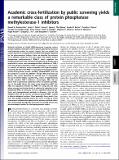| dc.contributor.author | Mohr, Justin T. | |
| dc.contributor.author | Speers, Anna E. | |
| dc.contributor.author | Wan, Chu | |
| dc.contributor.author | Spicer, Timothy P. | |
| dc.contributor.author | Fernandez-Vega, Virneliz | |
| dc.contributor.author | Chase, Peter | |
| dc.contributor.author | Hodder, Peter S. | |
| dc.contributor.author | Schürer, Stephan C. | |
| dc.contributor.author | Nomura, Daniel K. | |
| dc.contributor.author | Rosen, Hugh | |
| dc.contributor.author | Cravatt, Benjamin F. | |
| dc.contributor.author | Bachovchin, Daniel A. | |
| dc.contributor.author | Berlin, Jacob M. | |
| dc.contributor.author | Fu, Gregory C. | |
| dc.date.accessioned | 2011-11-09T21:51:44Z | |
| dc.date.available | 2011-11-09T21:51:44Z | |
| dc.date.issued | 2011-03 | |
| dc.date.submitted | 2010-11 | |
| dc.identifier.issn | 0027-8424 | |
| dc.identifier.issn | 1091-6490 | |
| dc.identifier.uri | http://hdl.handle.net/1721.1/66989 | |
| dc.description.abstract | National Institutes of Health (NIH)-sponsored screening centers provide academic researchers with a special opportunity to pursue small-molecule probes for protein targets that are outside the current interest of, or beyond the standard technologies employed by, the pharmaceutical industry. Here, we describe the outcome of an inhibitor screen for one such target, the enzyme protein phosphatase methylesterase-1 (PME-1), which regulates the methylesterification state of protein phosphatase 2A (PP2A) and is implicated in cancer and neurodegeneration. Inhibitors of PME-1 have not yet been described, which we attribute, at least in part, to a dearth of substrate assays compatible with high-throughput screening. We show that PME-1 is assayable by fluorescence polarization-activity-based protein profiling (fluopol-ABPP) and use this platform to screen the 300,000+ member NIH small-molecule library. This screen identified an unusual class of compounds, the aza-β-lactams (ABLs), as potent (IC50 values of approximately 10 nM), covalent PME-1 inhibitors. Interestingly, ABLs did not derive from a commercial vendor but rather an academic contribution to the public library. We show using competitive-ABPP that ABLs are exquisitely selective for PME-1 in living cells and mice, where enzyme inactivation leads to substantial reductions in demethylated PP2A. In summary, we have combined advanced synthetic and chemoproteomic methods to discover a class of ABL inhibitors that can be used to selectively perturb PME-1 activity in diverse biological systems. More generally, these results illustrate how public screening centers can serve as hubs to create spontaneous collaborative opportunities between synthetic chemistry and chemical biology labs interested in creating first-in-class pharmacological probes for challenging protein targets. | en_US |
| dc.description.sponsorship | National Institutes of Health (U.S.) (grant CA132630) | en_US |
| dc.description.sponsorship | National Institutes of Health (U.S.) (grant MH084512) | en_US |
| dc.description.sponsorship | National Institutes of Health (U.S.) (grant GM57034) | en_US |
| dc.description.sponsorship | National Institutes of Health (U.S.) (grant GM086040) | en_US |
| dc.description.sponsorship | National Science Foundation (U.S.) | en_US |
| dc.description.sponsorship | California Breast Cancer Research Program | en_US |
| dc.description.sponsorship | Skaggs Institute for Chemical Biology | en_US |
| dc.language.iso | en_US | |
| dc.publisher | National Academy of Sciences | en_US |
| dc.relation.isversionof | http://dx.doi.org/10.1073/pnas.1015248108 | en_US |
| dc.rights | Article is made available in accordance with the publisher's policy and may be subject to US copyright law. Please refer to the publisher's site for terms of use. | en_US |
| dc.source | PNAS | en_US |
| dc.title | Academic cross-fertilization by public screening yields a remarkable class of protein phosphatase methylesterase-1 inhibitors | en_US |
| dc.type | Article | en_US |
| dc.identifier.citation | Bachovchin, D. A. et al. “Organic Synthesis Toward Small-Molecule Probes and Drugs Special Feature: Academic cross-fertilization by public screening yields a remarkable class of protein phosphatase methylesterase-1 inhibitors.” Proceedings of the National Academy of Sciences 108 (2011): 6811-6816. Web. 9 Nov. 2011. © 2011 National Academy of Sciences | en_US |
| dc.contributor.department | Massachusetts Institute of Technology. Department of Chemistry | en_US |
| dc.contributor.approver | Fu, Gregory C. | |
| dc.contributor.mitauthor | Bachovchin, Daniel A. | |
| dc.contributor.mitauthor | Berlin, Jacob M. | |
| dc.contributor.mitauthor | Fu, Gregory C. | |
| dc.relation.journal | Proceedings of the National Academy of Sciences of the United States of America | en_US |
| dc.eprint.version | Final published version | en_US |
| dc.type.uri | http://purl.org/eprint/type/JournalArticle | en_US |
| eprint.status | http://purl.org/eprint/status/PeerReviewed | en_US |
| dspace.orderedauthors | Bachovchin, D. A.; Mohr, J. T.; Speers, A. E.; Wang, C.; Berlin, J. M.; Spicer, T. P.; Fernandez-Vega, V.; Chase, P.; Hodder, P. S.; Schurer, S. C.; Nomura, D. K.; Rosen, H.; Fu, G. C.; Cravatt, B. F. | en |
| mit.license | PUBLISHER_POLICY | en_US |
| mit.metadata.status | Complete | |
